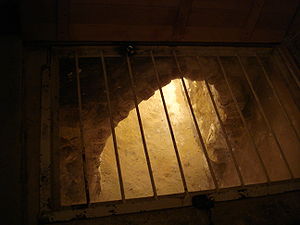 Image via Wikipedia
Image via WikipediaAs an avid reader of history, conventional wisdom tells us that the first glimmers of organized society are only 12,000 years old or so, with basic settlements, social hierarchy, crude agriculture and the domestication of animals emerging very slowly as the world thawed and the glaciers retreated. This framework works for my book series but I would still be thrilled if evidence appeared of relatively advanced societies -- along the lines of Cretan or Minoan civilization -- were found to exist 20,000 or even 40,000 years ago. Wouldn't that make for some interesting plot lines?
News out of the U.K. this weekend is that the recent dry weather there has caused literally thousands of ancient settlement sites, from Roman ruins to settelments thousands of years earlier, to suddenly become evident because of variations in crop coloring. Soil over some ancient settlement structures, like ditches or holding ponds, may hold moisture somewhat more efficiently and produce a deeper green. An old wall, on the other hand, might rob surface crops of moisure in specific patterns, giving another clue. From the air, faint patterns of old forts, walls, ditches and settlements fairly jump out to an observer or a camera, the English Heritage organization reports.
The more experts look, the more patterns of human exploration and settlement are found. So, to my mind and imagination, rarely is a woods just a woods. If you look and listen closely, the buzz of prior human activity becomes almost a roar. If you'd like to explore how several people from the Washington area reluctantly get involved in often harrowing activities strongly influenced by an obscure ancient civilization, please check out the book Gettysburg Passage now available on amazon.com.





![[From the southeast, Cardiff Castle, Wales] (LOC)](http://farm3.static.flickr.com/2528/3752438888_a25718f6f4_m.jpg)




